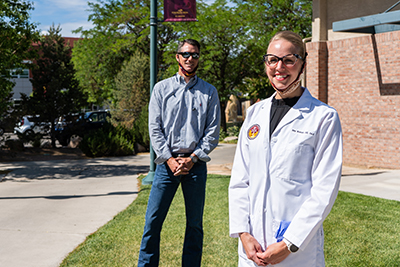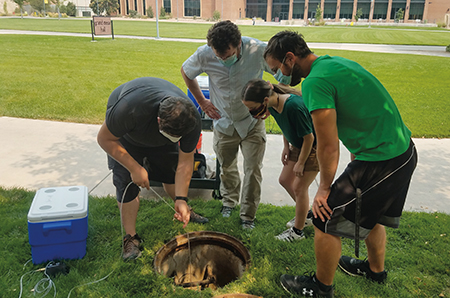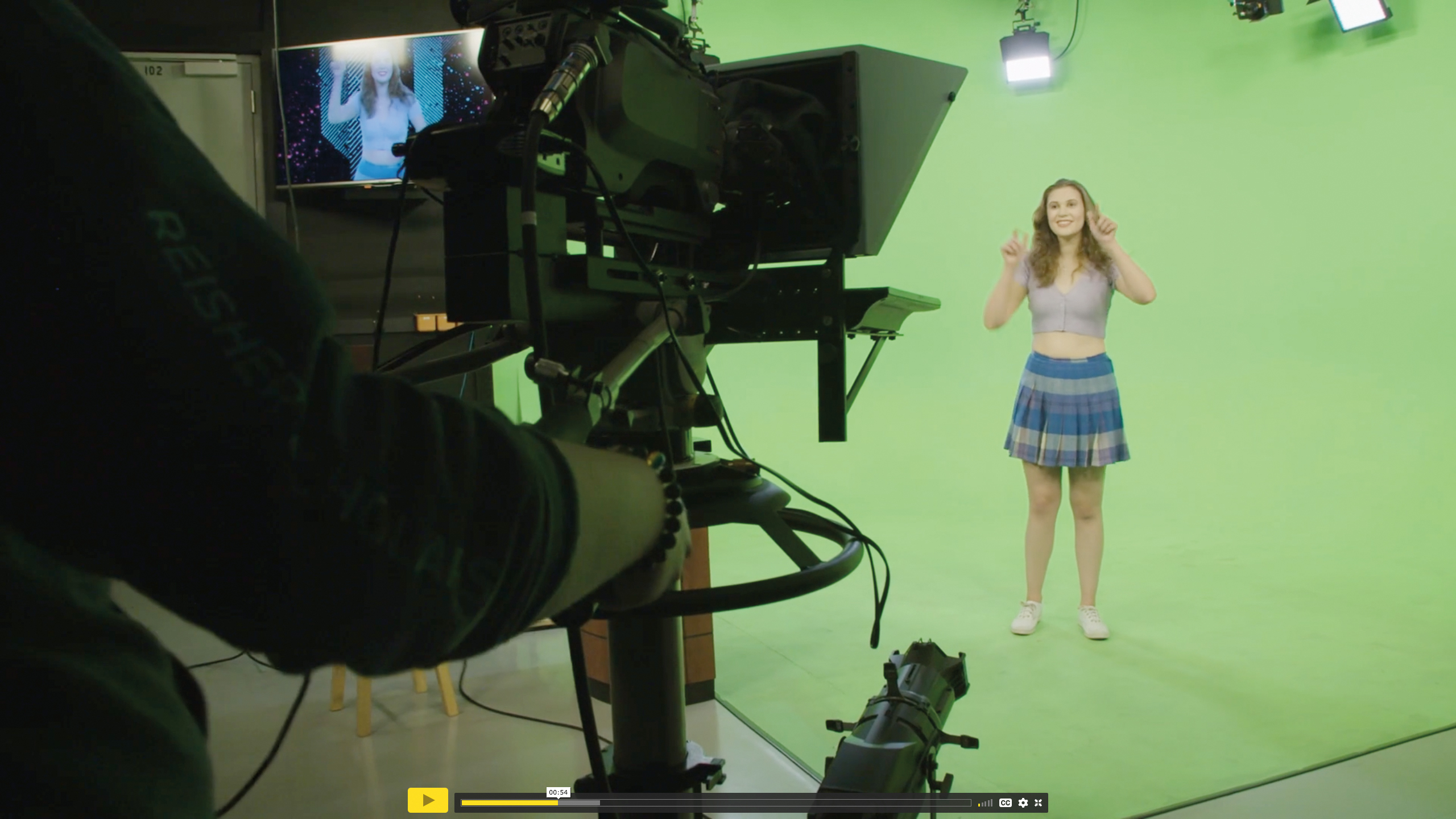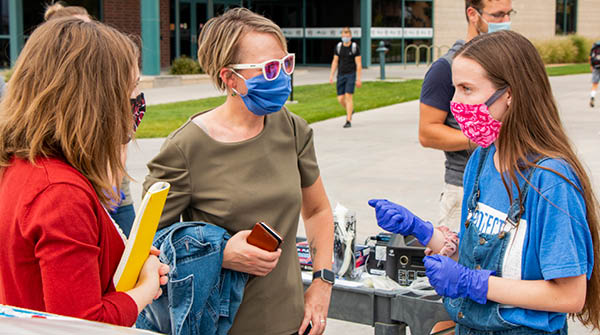Mavericks' ingenuity turned 2020 challenges into opportunities
Few among us aspire to become characters in a Michael Crichton pandemic novel, but every plotline needs heroes.
In the middle of a worldwide pandemic and chaos emerged an entire campus of forward thinkers, who proved ordinary people can become every day heroes. When the COVID-19 virus revealed its frightening formidability in the spring of 2020, Colorado Mesa University’s staff, faculty and students started thinking creatively about how to fight the virus and not only survive the challenges but thrive.
A bold but measured plan to mitigate the threat of the coronavirus was devised by CMU’s ensemble cast that included university administrators, leading faculty members, top students, national experts and other outside partners. CMU Vice President John Marshall said it all began with strong, decisive, well-conceived leadership from university President Tim Foster, who decided early to summon multiple resources and devise a formidable blueprint to combat an enemy that was largely a mystery.
“When we all got sent home due to state shelter-in-place orders last spring most of us were struggling to figure out what it meant for our day-to-day lives,” Marshall said. “As we were going through that, President Foster stepped up to provide some direct clarity.”
Like colleges and universities throughout the U.S., CMU closed its campus after spring break in March 2020 and students finished the semester online.
“President Foster laid it out for all of us,” Marshall said. “He said, ‘Look, we’re going to make the moral case for why we must come back for on-campus classes in the fall’.”
The case: A majority of CMU students are the first in their family to attend college or are low income — demographics that, according to national studies, don’t do as well in online classes.
“Defining our ‘why’ was such a vital starting point,” Marshall said of the decision to become one of the few universities in the country that opted for in-person classes in the fall of 2020. “Saying, ‘We are going to find a way to do this, and do it safely’ really set the tone for us.”
The university’s initiative, Safe Together, Strong Together, was announced in May 2020, leaving approximately three months for Marshall and Amy Bronson, EdD, director of CMU’s Physician Assistant Studies Program, to co-chair the initiative and lead a team that would collaborate with experts from Mesa County Public Health, Community Hospital and St. Mary’s Hospital, among others.

“The goal was to create a rigorous science- and health-focused plan that acknowledges the existence of COVID-19 in our community,” Bronson said. “The safer/stronger approach helped us reenvision what the campus community looked like and how we could build a safe campus community given that reality.”
A limited reopening of the campus began in May 2020 with access to the Hamilton Recreation Center, The Maverick Store and several outdoor recreation facilities under social distancing measures, equipment disinfecting procedures, virus screening and facility management.
Another challenge – getting buy in and ownership from the student body – was answered by Associated Student Government President Angel Bautista, who recorded a video in late August 2020 that asked returning students to think logically about becoming a team player in the campus effort.
“Other universities that reopened their campuses closed in just one week because students refused to take responsibility for their own future and education — because students didn't choose to fulfill their part of a plan,” Bautista said. “Every Maverick has to ask, starting now, ‘Is maintaining the culture of partying in college worth giving up an entire year of being on campus?’”
In subsequent weeks and months, a collective brainstorm swept through the campus community that was eager to find creative solutions to unique challenges.
One of the most ambitious campus initiatives was a decision to assemble a team of science, engineering and technology students and faculty members to design and build a wastewater testing unit. The unit was designed to explore the waste flow from campus residence halls for signs of the COVID-19 virus.
“I got involved through a campus club called Engineers Without Borders,” said Bryn Loftness, a computer science major who graduated this past December. “As I was first hearing about the project, I had to talk myself through it because it’s definitely something that’s unique in its own space.”
Loftness and four other students were summoned back to campus early from summer break and spent approximately three weeks in late August and early September 2020 working with faculty members designing, assembling and testing units that would extract samples from sewage flowing from campus buildings over a 24-hour period. Samples were tested for the presence of the coronavirus and those results helped determine where an outbreak might be likely.
“It sounds a little weird, but it was very exciting when we’d hear someone flush. Then we’d watch whatever excrements passed by our prototype,” Loftness said with a laugh. “Some of us would back away and some of us put our heads even farther down the manhole to get a better look.”

Once the virus was detected, the occupants of that building were tested using individual diagnostic tests with help from assistant professors of biological sciences Megan Sherbenou, PhD, and Matthew Stansbury, PhD. Students who tested positive were found and isolated, and close associates of those students were located through the efforts of CMU’s contact tracers who had been trained and deputized by Mesa County Public Health.
“It was these folks [students, faculty and staff] who were taking late night phone calls, early morning phone calls, then making sure anyone who showed up with a positive COVID-19 test was notified along with anyone they had associated with,” Bronson said. “It was really their work that allowed us to keep the virus from spreading.”
“We prevented five or six outbreaks thanks to those people who were out there building, collecting, doing analysis, looking at data and testing,” Marshall said. “A lot of different people worked carefully and effectively together.”
Those who were then quarantined were assisted by two groups — Residence Life on campus and Young Life College off campus, which assembled care packages for the students.
Beyond local partners, the CMU wastewater project attracted research collaborators including Dr. Pardis Sabeti, head of Sabeti Lab, one of the world’s premier genetic research labs at Harvard University.
“I was getting advice once a week on Zoom calls, sometimes one-on-one, from Dr. Sabeti, a computational researcher who collects data for germ and health models, which is exactly what I’m interested in doing,” said Loftness. “Meeting with a leader in this field definitely affected my trajectory especially as I apply for further research programs.”
CMU’s team also collaborated on the wastewater project with engineers at the University of Colorado Boulder, who built a similar device. The educational experiences for students were not limited to the wastewater unit team.
“We really looked at this pandemic problem as a learning opportunity. A time where students could be part of the response including our nursing students, who were out there on our frontlines performing COVID tests in 100-degree weather,” said Bronson.
Baseline testing was conducted July 27, 2020, through the first week of Fall 2020 classes and included all students, faculty and staff. The testing included saliva tests for screening and nasal swabbing for diagnostic testing. The tests resulted in early detection of cases prior to students returning to campus. This detection quickly honed the university’s skills in responding to COVID-19 through contact tracing.
“Thanks to the tenacity of our team and partners, we created four testing centers across the state that were complimented with at-home and third-party testing while we administered 9,014 tests at our on-campus site,” Marshall said, with now more than 30,000 tests administered by CMU’s on campus testing center. “Our on-campus testing site identified 20 of the 37 initial cases and enabled our team of contact tracers to work closely with partners at Mesa County Public Health to find, inform and isolate those impacted before they could broadly interact with the campus community.”
The university also partnered with Dr. Sabeti to introduce CMU students to Operation Outbreak, an app that challenges players to track a virtual virus across the campus and learn how to stop the spread — approximately 300 students participated and the project was mentioned in the New York Times.
CMU’s theatre department was among the first innovators to seize the opportunity to circumvent the coronavirus.
“Fairly early in the pandemic, research was telling us that the disease was communicated through aerosol, and almost everything we do involves projecting, speaking loudly,” said Department of Theatre Arts Head Mo LaMee. “For dancers, it’s all about working hard, breathing intensely. That was a big problem to wrap our heads around.”
The solution, daunting as it seemed, was for LaMee’s team of actors, designers and technicians to offer digital options for viewing all six productions for the 2020-21 season. With only one exception, all of the plays and dance concerts were offered live with limited, socially distanced seating as well as virtually through digital streaming. The
second show of the season, She Kills Monsters, a play depicting the Dungeons and Dragons gaming world was completely removed from the theatre setting and shot as a film in a studio. In each case, the theatre department teamed up with CMU-TV to deliver the productions virtually.
“Particularly with She Kills Monsters, it forced us to figure out how to present in a way that we hadn't ever presented before, and collaborate outside of our own department,” LaMee said.
The challenge of depicting a fantasy world prompted LaMee to reach out to CMU Mass Communication Instructor Greg Mikolai, whose expertise enabled LaMee to film the entire performance in front of a green screen.

“We were filming every single actor separately backed by a green screen in scenes that sometimes had eight or nine people in them,” LaMee said. “We only rehearsed for eight days, instead of the usual five or six weeks, then we had to get in the studio and start shooting. It was remarkable to watch our actors stay focused and act to a camera without any interaction with another actor. That’s contrary to all of their training.”
The green screen footage enabled LaMee to collaborate with CMU’s animation and design students, who created the dragons, monsters and fantasy backgrounds. Darin Kamstra, DMA, head of the music department, created an original score for the film.
“It was really thrilling because we had overcome so many obstacles to make the film. We did things we never would have done under normal circumstances,” LaMee said.
CMU documented their journey to create these productions through its Maverick Network show called Script Flip, which can be viewed at coloradomesa.edu/maverick-network.
The first production of the season, Naked Mole Rat Gets Dressed, was viewed online by more than 4,000 Mesa County Valley School District 51 elementary school students — an exhilarating accomplishment for the performers, who were required to stay 6-10 feet apart and respect detailed protocols throughout the production.
Several members of the Naked Mole Rat Gets Dressed cast also made an in-person visit, in full costume, to a local elementary school to promote the play. The performance resulted in the award-winning children’s book author reaching out directly to one of the elementary school students who was in the audience and is facing a life-threatening condition.
“The fact that our efforts to navigate the pandemic also resulted in Mo Willems expressing love and care for a child shows good can come from a time when things can seem grim,” said LaMee.
CMU’s efforts to keep the pandemic in check on campus was an unmitigated success story due to the many faculty, staff and students who proved ordinary people can become every day heroes. At the end of November 2020, when students went home for Thanksgiving break, Mesa County’s coronavirus infections were approaching the 2,000 mark, while CMU’s count was still low.
“I can’t say enough about the people who served on our internal committees who addressed the question, ‘How are we going to adapt and change everything from academics to student services and student life?’” Bronson said. “We do run a small village here.”
The university opened for in-person classes for the Spring 2021 semester on January 25 after launching The Future is Now pandemic response plan update. This update is helping the campus community continue to innovate and adapt to every new obstacle.
